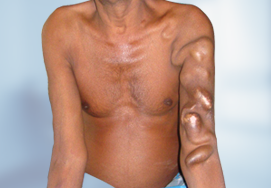Carpal Tunnel Syndrome
Performed if your symptoms haven’t improved after several weeks of nonsurgical treatment,there is a persistent loss of feeling or coordination in your fingers or hand, there is decreased strength in the thumb, and your sleep is severely disturbed by pain.

- What is Carpal Tunnel Syndrome?
- What are the non-surgical options for treatment?
- Which individuals are suitable for the surgery?
- What are the types of the surgeries?
- How should I prepare for the surgery?
- What will happen during the surgery?
- What is the aftercare of the surgery?
- What are the postsurgical considerations?
What is Carpal Tunnel Syndrome?
Carpal Tunnel Syndrome (CTS) is manifested with pain, numbness, weakness, and tingling in the hand and arm. CTS is caused primarily due to compression of a median nerve in your wrist. This median nerve is responsible for the sensation and controlling the movement in your thumb, long finger, index finger, and part of the ring finger. CTS also results from fluid retention or continual repetitive movements in the wrist tunnel (carpal tunnel).
Carpal tunnel release surgery is performed by cutting the transverse carpal ligament which relieves pressure on the median nerve in the wrist thereby relieving symptoms associated with CTS.
What are the non-surgical options for treatment?
Symptoms can be improved by wearing a wrist splint or with corticosteroid injections.
Splints
A therapy using splints is indicated for light and moderate pathology. Current recommendations generally don’t suggest immobilizing braces, but instead activity modification and non-steroidal anti-inflammatory drugs as initial therapy,
Corticosteroid injections can be effective for temporary relief from symptoms while a person develops a long-term strategy that fits their lifestyle. This treatment is not appropriate for extended periods
Surgery to cut the transverse carpal ligament is effective with better results at a year compared to non-surgical options. Further splinting after surgery is not needed.
Which individuals are suitable for the surgery?
Most of the people with CTS are initially prescribed non-surgical treatment methods.
Early surgery with carpal tunnel release is indicated where there is evidence of median nerve denervation or a person elects to proceed directly to surgical treatment
Your surgeon may suggest surgery when the CTS symptoms restrict your normal daily activities and if:
- Your symptoms haven’t improved after several weeks of nonsurgical treatment.
- There is a persistent loss of feeling or coordination in your fingers or hand.
- There is decreased strength in the thumb.
- Your sleep is severely disturbed by pain.
- You have underlying medical causes such as arthritis or inherited genetic conditions
- There is damage to the median nerve or when there is a risk of damage to the nerve
What are the types of the surgeries?
The carpal tunnel release surgery is performed in two ways that include:
- Open carpal tunnel release surgery has fewer chances of complications when compared to the endoscopic carpal tunnel release surgery. In this technique, pressure on the median nerve is release by cutting the transverse carpal ligament. The surgery involves longer period of recovery and also leave a larger scar.
- Endoscopic carpal tunnel release surgery approach is best suited for those who prefer quicker recovery compared to open surgery. This surgery is also associated with less pain and smaller scar compared to open surgery. Endoscopic surgery may slightly have chances of needing another surgery later. It cannot be used in all cases.
How should I prepare for the surgery?
Carpal release surgery is performed in on day care basis and may not require an overnight stay at the hospital. Before the surgery, you should:
- Avoid taking few medications such as aspirin two weeks before your scheduled surgery.
- Inform your surgeon if you experience any illness before surgery.
- Inform your surgeon about all medicines and supplements you are using.
- Avoid eating or drinking for atleast six to 12 hours before the surgery.
What will happen during the surgery?
You surgeon may recommend surgery if the symptoms last for more than six months. You will be given local anesthesia for any of the procedure.
In open release surgery, your surgeon makes a small incision up to 2 inches in your wrist. Then, the /surgeon cuts the carpal ligament to enlarge the carpal tunnel which helps in relieving the pressure on the median nerve. Your surgeon may also remove some tissue around the median nerve depending on your condition. After that, stitches are applied to close the wound and the wound is covered with bandage.
In endoscopic surgery, your surgeon makes two incisions about ½ inch each in the wrist and palm. The surgeon then inserts an endoscope attached to a tube, into your wrist to observe the tissue on a screen. Your surgeon then inserts other tools through the opening and cut the carpal ligament to reduce pressure on the median nerve. After that, the tools and endoscope are removed from the hand and the incision is closed with a stitch.
What is the aftercare of the surgery?
Your surgeon may discharge you on the same day of the surgery and schedule a follow-up visit after 10 to 14 days after surgery to remove stitches. You should,
- Avoid heavy use of your hand involved in the surgery for up to 3 months.
- Undergo physical therapy before returning to the work.
What are the postsurgical considerations?
Risks associated with carpal tunnel release surgery include:
- Bleeding
- Infection
- Nerve damage
- Stiffness
- Pain at the scar
- Loss of strength in the wrist
- Allergic reaction to anesthesia or pain medication














